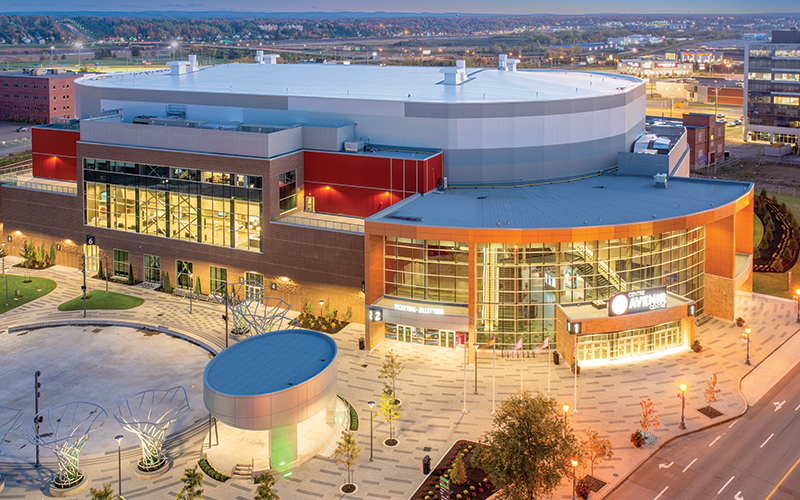Account Login
Don't have an account? Create One

LOOK ANYWHERE IN DOWNTOWN MONCTON and it’s hard to escape the impression that a commercial renaissance is underway. New buildings and construction reach for the sky.
There’s the new $100 million Avenir Centre and public plaza complete with outdoor skating rink, which opened a year ago on the corner of Main Street and Canada Street. To the west of it, on former CN railway lands, the Junction Urban Village development rises to beckon business and residential tenants, alike.
To the east, a new Hyatt Place is nearly complete. Then there’s the commercial and residential development FiveFive Queen – home to a new hotel, plus apartment and condo living, Gahan House and Expérience by ANBL, a trendy new wine store. There’s also the Hilton Garden Inn under construction on Highfield Street and a multi-residential apartment project underway at the corner of St. George and Weldon Streets. If that’s not enough, downtown is abuzz with the opening of Timber Lounge, Euston Park Social, a gastro beer garden and several independent boutique retailers.
Altogether, these projects will help the city’s construction sector expand by 2.7 per cent this year and 2.2 per cent in 2020, reports the Conference Board of Canada’s 2019 Outlook report on Moncton. That’s after the industry’s output rose by an average of 13.4 per cent annually over 2016 and 2017 and by an additional 13.8 per cent last year.
In fact, none of this is accidental. It has been part of a development plan Moncton City Council has invested in and led through multiple initiatives, projects and programs including: the award winning Avenir Centre, the Downing Street project, the refurbishment of the CN Subway Main Street crossing, riverfront improvements, and finally the downtown and heritage financial incentive program. “We have seen the private sector respond and actively support and participate in this revitalization plan,” says Economic Development Director Kevin Silliker.
Late last year, Moncton City Council expanded the geographic area of its downtown development financial incentive program, designed to generate growth and density in the urban core. The move helped boost what was already measurable momentum in the commercial sector.
“In 2019, for the year-to-date period ending in June, the total value of new development in downtown was $32.4 million,” Silliker says. “In 2018, it was $30 million. In 2017, it was $45 million. Before the Avenir Centre, downtown building permits were in the range of $8 million per year on the low end to $20 million per year as a high. So, that says a lot. Our goal is to help as many new, qualified proposals as possible actually cross the finish line.”
Incentives notwithstanding, what lies beneath has been familiar for years, if not decades: a sturdy foundation for growth. Moncton remains one of the most economically successful, demographically dynamic and commercially competitive urban areas in Atlantic Canada. “A healthy, vibrant city relies on a dynamic, growing downtown area,” says Moncton Mayor Dawn Arnold. “In Moncton, we have all the ingredients for long-term success and prosperity.”
The Conference Board forecasts the urban economy will grow by 1.8 per cent this year and by 1.9 per cent in 2020, compared with a 1.9 per cent increase in 2018. Although employment growth is expected to taper off in 2019-20, this comes on the heels of last year’s galloping job growth rate of 4.5 per cent. After falling to a 10-year low of 5.7 per cent last year, the average unemployment rate will remain steady in 2019 before edging down to 5.6 per cent next year.
Meanwhile, Statistics Canada data shows that between 2011 and 2016, Moncton’s head count rose by an average of 1.4 per cent a year. In fact, Greater Moncton’s population is growing by approximately 2,000 people per year. About 50 per cent of that growth comes from newcomers who are adding enormous positive value to the economy and community. What’s more, over the next two years, household incomes and retail sales – buoyed by diverse white-collar jobs – are forecast to grow by between two and three per cent, and three and 3.5 per cent, respectively.
Not surprisingly, then, property developers in the municipal centre are finding good reasons for building. In 2018, absorption in the downtown Moncton office market was 168,058 square feet, pushing the vacancy rate down to 7.3 per cent in the fourth quarter of that year, compared with 12.6 per cent in the year-earlier period. At the same time, average net rental rates have only risen 16 cents per square foot to $12.85 cents, overall, among Class A, B and C properties.
Finally, apartment and multi-residential vacancy rates are now 2.7 per cent across the urban region, making this market very attractive for investment.
All of which really is a recipe for Moncton’s downtown renaissance. Or, as Mayor Arnold notes, “We have a story to tell and we are telling it.”
Comment policy
Comments are moderated to ensure thoughtful and respectful conversations. First and last names will appear with each submission; anonymous comments and pseudonyms will not be permitted.
By submitting a comment, you accept that Atlantic Business Magazine has the right to reproduce and publish that comment in whole or in part, in any manner it chooses. Publication of a comment does not constitute endorsement of that comment. We reserve the right to close comments at any time.
Cancel